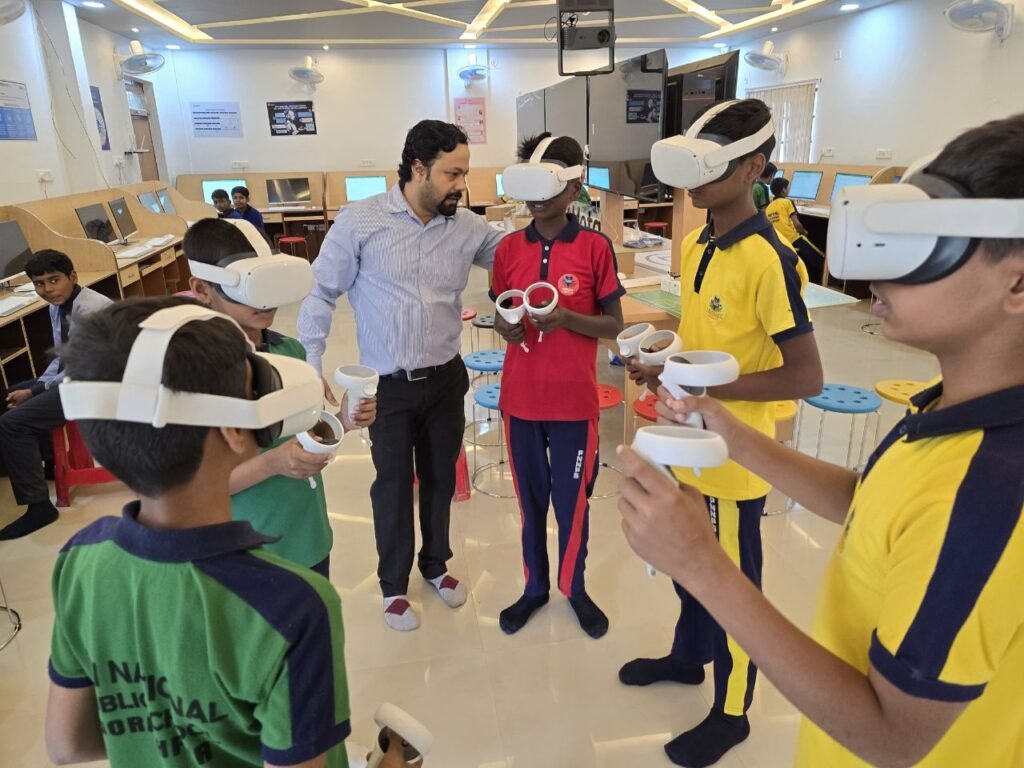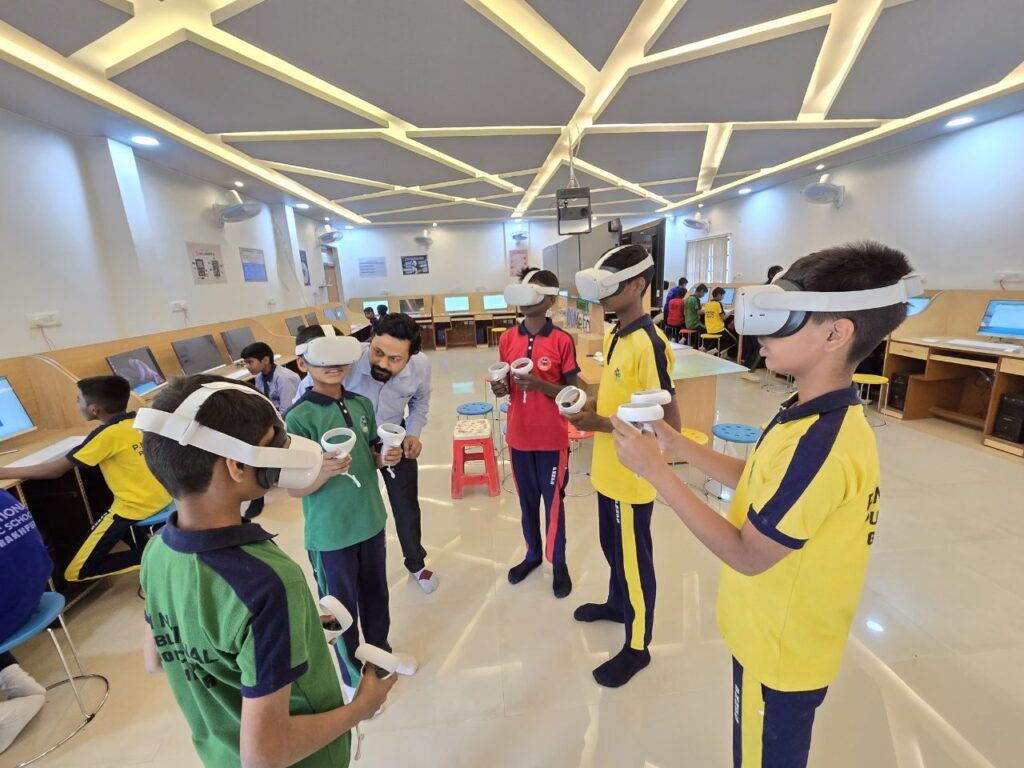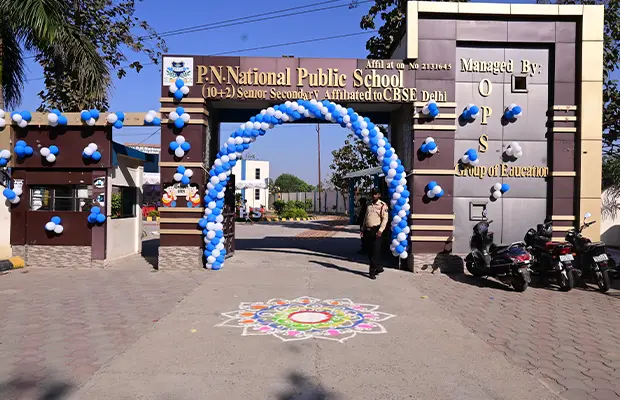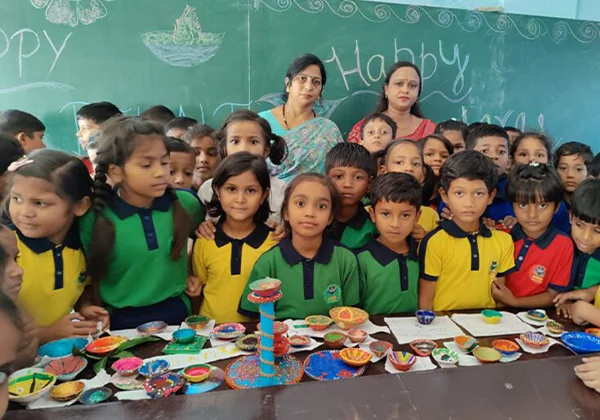Introduction
What is virtual reality in the context of education?
Virtual reality, or VR for short, is a simulated experience of a three-dimensional environment. The most common way to access VR is through a virtual reality headset, such as the Meta Quest, the Sony PlayStation VR, or the Apple Vision Pro. Virtual reality allows users to look around, move, and interact with their surroundings. Virtual reality has potentially endless use cases, going from virtual museum visits to letting medical students practice surgery on a virtual patient. In the case of education, VR may enable students to experience otherwise impossible scenarios, such as visiting far-away cultural sites or traveling back in time from the comfort of the classroom.
Overview of current uses and benefits
Virtual reality has many potential applications in education: besides making virtual museum visits much more immersive, it can help chemistry or biology students conduct experiments in a safe environment. Art students may see a virtual art gallery or even exhibit their creations side by side with famous paintings or in their favorite museum. With the decreasing cost of the necessary equipment, the number of potential applications for VR in education has grown enormously, and this trend is still ongoing. Virtual reality can revolutionize both how educators teach and pupils learn.
What are some potential uses of VR in education?

Science, technology, engineering, and math (STEM) education
Let’s explore a few ways of applying virtual reality to STEM subjects.
In a physics class, students may simulate how gravity affects the world around us and experience first-hand what it would be like to walk on the Moon or another celestial body. Students may go for a virtual field trip to see how wind farms generate electricity or understand a particle accelerator’s inner workings. In addition, students may carry out physics experiments that would be dangerous or difficult to replicate in real life.
VR could benefit engineering students by allowing an engaging way to design and prototype models at no cost. The added benefit is that many issues can be identified and fixed before building a physical prototype. VR would also be helpful when putting together a project, allowing students to visualize the assembly process in three dimensions. VR would also let students experiment with scenarios that would be unsafe or complicated to test in the real world, such as an extreme load on a bridge, and study the potential consequences of such a scenario.
P N National Public school students can also benefit from many virtual and augmented reality applications for STEM subjects: tools such as i3LEARNHUB let students experiment with augmented reality (AR), helping them visualize cells and organs through Lifeliqe.
Using virtual reality to learn a new language
Students can use VR to learn a new language: immersion is crucial when getting to know a different culture, and virtually visiting a country and interacting with native speakers can help with immersion. Rather than exclusively studying through video or text, students can immerse themselves in a virtual environment. A potential use of VR to practice a foreign language could be ordering a coffee or a meal at a restaurant, helping the students grow more confident in their language skills while knowing they are in a safe environment and without the prohibitive travel costs.
Virtual field trips and lab simulations
As can be noticed from the previous paragraphs, an essential use of virtual reality is allowing students to go on virtual field trips at a fraction of the cost. Virtual field trips apply to different subjects and pedagogical areas, from history and geography to a completely simulated chemistry lab where students can carry out exciting experiments.
VR can also let students with physical disabilities visit places that would otherwise be impossible or difficult. Students with social disabilities may benefit from using VR, knowing they can interrupt the experience as soon as they feel uncomfortable.
The benefits of VR in the classroom

Immersive learning experiences
VR can be beneficial for students in several ways. For example, they can access real-world experiences in a variety of contexts. VR is inherently safe, as students can carry out dangerous experiments or explore challenging environments from the safety of the classroom. VR can also promote collaboration between students in ways that were impossible before.
Increased engagement and motivation
VR promotes active learning through immersive experiences in virtual environments, helping students hone their problem-solving skills. For elementary school students, VR can help improve retention and deepen engagement thanks to its immersive nature. VR benefits students who may have difficulty paying attention to traditional class lectures.
Research has shown that students are more motivated when using virtual reality in specific settings. In an article published in the International Journal of Emerging Technologies in Learning, medical students were most motivated when learning through virtual reality: it outperformed video and text-based learning settings.
For more mature students pursuing medicine, research by Stanford University has found that the empathic response triggered by an elderly patient in a 360-degree video is much more powerful than reading text from case studies. Both augmented and virtual reality can significantly affect medical students’ learning, possibly altering their perspectives and way of approaching challenges in the future.
Improved retention and comprehension
By using virtual reality to assess students’ communication skills, McGovern and colleagues (2019) found that using VR in specific educational settings can be beneficial and even outperform traditional teaching methods. A significant improvement in learning gains was also found in a meta-analysis by Villena-Taranilla and colleagues (2022). However, the authors point out a need for more research in VR, explaining how more studies are needed to determine the exact impact of virtual reality on education.
Conclusion
To conclude, virtual reality (VR) can revolutionize teaching and learning. The technology offers immersive learning experiences that provide countless ways to experience the world around them, promoting collaboration and increasing engagement and motivation. Teachers of all grades can find practical applications of VR in most subjects, from STEM to language learning, history, and social studies. Visiting cultural sites from across the world, practicing their target language with native speakers, and conducting experiments in a safe environment are a few ideas that can make learning more fun and engaging for students.
While the advantages and potential uses of VR in the classroom are clear, it is also fundamental to consider this technology’s drawbacks. The cost of successfully installing and maintaining VR systems in a school is challenging, especially considering most institutions’ budgets and infrastructure limitations. In addition, it still needs to be clarified how VR affects learning outcomes, even though some studies have shown promising results.



Hi
I have just checked pnpsgkp.org for its SEO Trend and saw that your website could use a boost.
We will increase your ranks organically and safely, using only state of the art AI and whitehat methods, while providing monthly reports and outstanding support.
More info:
https://www.digital-x-press.com/unbeatable-seo/
Regards
Mike Attwood
Digital X SEO Experts
Hi there,
My name is Mike from Monkey Digital,
Allow me to present to you a lifetime revenue opportunity of 35%
That’s right, you can earn 35% of every order made by your affiliate for life.
Simply register with us, generate your affiliate links, and incorporate them on your website, and you are done. It takes only 5 minutes to set up everything, and the payouts are sent each month.
Click here to enroll with us today:
https://www.monkeydigital.org/affiliate-dashboard/
Think about it,
Every website owner requires the use of search engine optimization (SEO) for their website. This endeavor holds significant potential for both parties involved.
Thanks and regards
Mike Holiday
Monkey Digital
Howdy
This is Mike Erickson
Let me present you our latest research results from our constant SEO feedbacks that we have from our plans:
https://www.strictlydigital.net/product/semrush-backlinks/
The new Semrush Backlinks, which will make your pnpsgkp.org SEO trend have an immediate push.
The method is actually very simple, we are building links from domains that have a high number of keywords ranking for them.
Forget about the SEO metrics or any other factors that so many tools try to teach you that is good. The most valuable link is the one that comes from a website that has a healthy trend and lots of ranking keywords.
We thought about that, so we have built this plan for you
Check in detail here:
https://www.strictlydigital.net/product/semrush-backlinks/
Cheap and effective
Try it anytime soon
Regards
Mike Erickson
mike@strictlydigital.net